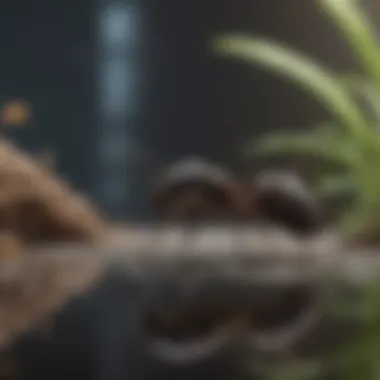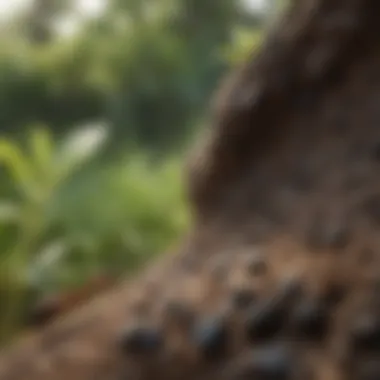Effective Strategies for Eliminating Black Ants


Intro
Dealing with black ant infestations can be a challenging task for many homeowners. These pests can invade your living space, causing not only annoyance but also damaging your food and property. Understanding effective strategies to eliminate them is essential. This article aims to provide a comprehensive guide, merging both natural and chemical solutions alongside best practices for prevention.
Key Insights and Trends
The landscape of pest control is evolving. Homeowners are increasingly seeking out environmentally friendly solutions. This trend is attributed to growing awareness regarding health impacts and ecological implications of chemical pesticides.
Shift Towards Natural Solutions
Natural remedies are gaining popularity. For instance, diatomaceous earth and vinegar are commonly recommended. These options not only serve to eliminate black ants effectively but also reduce the risk of harm to other non-target species and human health, contrasting with traditional chemical methods.
Increased Focus on Prevention
Prevention is taking precedence in ant management. Homeowners are focusing on eliminating potential entry points and food sources. This proactive approach helps in minimizing the appeal of your home to black ants.
"A motivated homeowner can often outsmart these tiny pests by understanding their habits and preferences.”
Practical Tips and How-To Guides
To effectively eliminate black ants, it is crucial to have a structured plan. Here are some practical steps you can take:
Step 1: Identification
Before proceeding, accurately identify the ant species. Black ants, often found in both indoor and outdoor settings, have specific behaviors and preferences that can influence your strategy.
Step 2: Create Barriers
Seal any entry points around your home. Use caulk or similar materials to close gaps in walls, windows, and foundations. This simple measure can significantly deter ants from entering.
Step 3: Remove Food Sources
Clean up regularly and store food in airtight containers. This reduces the appeal of your kitchen and pantry areas to ants.
Step 4: Use Natural Remedies
Consider applying natural deterrents. Mixtures of soap and water or vinegar can disrupt ant trails. Spray these substances in the areas where you see ants.
Step 5: Consider Chemical Solutions
If the infestation persists, explore options like Terro Liquid Ant Baits or Advion Ant Gel. Chemical methods should be used cautiously, keeping in mind their potential health impacts.
Step 6: Monitor and Adapt
After implementing these strategies, monitor the situation. Look for new ant activity and be ready to adapt your approach if needed.
The combination of these approaches, both natural and chemical, allows for a comprehensive strategy to address black ant issues. By being informed and proactive, homeowners can reclaim their spaces while being considerate of their environment.
Understanding Black Ants
Understanding black ants is crucial for anyone facing infestations in their homes. Black ants can be more than just a nuisance; they can become a sign of larger issues. Knowing their biology, behavior, and habits can provide insight into effective control methods. The more informed you are about these insects, the better your chances of preventing their return.
Biology and Behavior
Black ants are part of the Formicidae family. They typically exhibit a strong social structure, living in colonies that can number in the thousands. Their lifespan can vary, with worker ants living up to a few months, while queens can survive for several years. These creatures play a significant role in the ecosystem; however, when they invade living spaces, they can create stress and damage.
Black ants are omnivorous, feeding on substances like sweets, proteins, and oils. This adaptability in diet makes them a common sight in human dwellings, especially when food sources are readily available. Their penchant for scavenging means that they often travel in trails, which can lead to a substantial infestation if not managed early.
Common Species in Urban Areas
There are several black ant species prevalent in urban settings, such as the Pavement Ant and the Odorous House Ant.


- Pavement Ant: This species is commonly found in cracks in pavements and along buildings. They tend to invade homes in search for food, particularly in spring and summer.
- Odorous House Ant: Notable for its unpleasant smell when crushed, this ant species builds nests in walls and insulation. They are aggressive foragers and can become a persistent problem if not addressed.
Understanding these specific species aids homeowners in adopting precise methods for control and eradication.
Identifying an Infestation
Identifying an infestation of black ants is crucial in the process of effective pest control. Recognizing the early signs can help prevent a minor issue from developing into a significant problem. Understanding the behavior and habits of black ants allows homeowners to act swiftly, minimizing damage to property and reducing the use of pesticides.
Several critical elements must be taken into consideration when identifying black ant infestations.
- Timing: Spring and summer are peak seasons for ant activity. Increased sightings during these seasons often signal the start of an infestation.
- Location: Black ants usually prefer to nest indoors in warm, damp locations or outside near food sources. Monitoring these areas regularly is key.
- Behavior: Noting the trails that ants follow can provide insights into their origin and allow for more targeted interventions.
By familiarizing oneself with these signs, homeowners can take the necessary steps for swift action.
Signs of Black Ants
Several signs indicate the presence of black ants in and around a home.
- Ant Trails: The most visible sign is the presence of trails. Black ants will establish a pheromone trail to and from their food sources.
- Nesting Areas: Finding nests is another clear indication. Indoors, nests may be found in walls, under floors, or near moisture sources. Outdoor nests are often in soil or under debris.
- Food Sources: If food is scattered or slightly damaged, it may suggest ants are foraging for sustenance.
Identifying ant trails and nests is essential in formulating an effective pest control strategy.
Common Entry Points
Understanding common entry points is necessary for effective prevention and treatment.
- Cracks and Gaps: Black ants can find their way indoors through small gaps around windows, doors, and foundations.
- Plumbing and Electrical Lines: Ants often venture through spaces around pipes and wires, giving them access to homes.
- Ventilation Openings: If not sealed correctly, attic and vent areas can allow ants to enter.
In summary, being proactive about identifying the signs of black ants and knowing their entry points aids significantly in managing an infestation. Consistent monitoring and evaluation of these factors can lead to timely action, preventing further spread.
Natural Remedies
Natural remedies for eliminating black ants are increasingly relevant for homeowners looking for effective solutions that are less harmful to the environment and health. These remedies offer a holistic approach to pest control, ensuring that while you eliminate ants, you can also maintain a safe and healthy living space. Understanding the various natural methods can empower homeowners, allowing them to choose strategies that align with their values and environmental considerations.
Vinegar Solutions
Vinegar has long been touted as a multi-use substance in households, and its role as an ant repellent is notable. The primary reason vinegar works effectively is due to its strong scent. When sprayed in areas where ants are seen, vinegar disrupts their ability to communicate and mark trails. Simply mixing equal parts water with white or apple cider vinegar in a spray bottle can provide a straightforward solution. It's essential to focus on places where ants frequently congregate, such as countertops, door frames, and windows.
- Benefits of using vinegar are twofold: it proves to be a natural deterrent and helps clean surfaces, removing sugary residues that attract ants.
- Considerations include the presumption that vinegar may not kill ants outright but rather repel them, which encourages homeowners to combine this method with other strategies if they aim for complete eradication.
Essential Oils
Essential oils are another powerful ally in managing black ant populations. Oils like peppermint, tea tree, and eucalyptus have proven repelling properties. Not only do they help deter ants due to their strong fragrances, but they can also create an unpleasant environment for them. To create a natural spray, mix a few drops of essential oil with water in a spray bottle and apply in areas infested by ants.
- Benefits of essential oils include their pleasant aroma, making them an attractive option over chemical solutions. They also provide potential antimicrobial properties.
- Considerations for using essential oils involve the need for dilution; applying them in their concentrated form can be too potent and might damage surfaces or fabrics.
Diatomaceous Earth
Diatomaceous earth (DE) is a natural pesticide sourced from the fossilized remains of tiny aquatic organisms. It works mechanically; when ants encounter DE, it lacerates their exoskeletons, resulting in dehydration. Homeowners can sprinkle food-grade diatomaceous earth in ant trails and entry points.
- Benefits include its long-lasting effectiveness and that it poses minimal risk to humans and pets when using food-grade product.
- Considerations involve ensuring that DE stays dry, as moisture can render it ineffective. Furthermore, as a powder, it may require regular reapplication after cleaning or rain.
Understanding how to use these natural solutions can enhance overall home hygiene and ensure a harm-free environment.
Chemical Solutions
Chemical solutions play a crucial role in managing black ant infestations effectively. While natural remedies offer an eco-friendlier approach, chemical products can provide immediate relief from pests. Understanding the proper use of these solutions is essential for both efficacy and safety.


Insecticides and Baits
Insecticides are designed to eliminate insects quickly and can be applied directly to an infestation. Common options for dealing with black ants include pyrethroids, which are synthetic chemicals mimic a natural insecticidal compound. Bait stations, on the other hand, attract ants who then return to their colony, sharing the poison with others. Popular insecticides such as Raid Ant Baits and Ortho Home Defense have established their effectiveness in household pest control.
When using baits, it is important to choose those specifically formulated for ants since other general insecticides may not be as effective. Ant baits are a slow-acting option, which allows ants to transport the toxic substance back to their nest, addressing the root of the problem.
Choosing the Right Product
The selection of the right chemical product is crucial for success. Here are some factors to consider:
- Target Species: Some products are more effective against specific ant species.
- Application method: Determine if you prefer sprays, granules, or bait.
- Residue: Some chemicals leave a residue that can be unsafe for pets and children.
Products such as Terro Liquid Ant Baits offer user-friendly solutions, while Ultrathon spray can be effective for immediate results. Researching product reviews and checking for relevant certifications can guide you in making an informed choice.
Safety Precautions
Using chemical solutions requires careful attention to safety to protect your health and the environment. Review the instructions on product labels thoroughly before application. Here are key safety measures to consider:
- Wear Protective Gear: Gloves and masks can minimize exposure to harmful chemicals.
- Ventilation: Ensure the area is well-ventilated when applying sprays.
- Storage: Keep products out of reach of children and pets to prevent accidental ingestion.
Always prioritize non-toxic options for areas frequented by children.
In addition, be aware of local regulations regarding chemical use to ensure compliance and minimize environmental impact. Proper disposal of leftover products is vital to avoid polluting water sources or harming wildlife. Monitoring for any signs of allergic reactions or adverse reactions after application is also recommended.
By understanding and implementing these guidelines, homeowners can manage black ant problems effectively while maintaining a safe living environment.
Methodologies for Application
In the quest to eliminate black ants, employing the right methodologies for application stands crucial. These approaches can drastically impact the effectiveness of any chosen strategy. Understanding how to effectively apply treatments, whether they are natural or chemical, determines not only the success rate but also the safety for both humans and pets.
Appropriate methodologies involve several factors: the right timing, the precision of application, and the selection of the method based on the specific situation. Using targeted approaches allows for more efficient treatment, minimizing unnecessary exposure to substances that might harm the environment. General spraying techniques provide broader coverage, but they also require careful consideration to avoid overuse or misapplication. Therefore, knowing when and how to use these methods is essential for effective pest control.
Targeted Approaches
Targeted approaches are essential for focused pest management. This method entails applying treatments directly where ant trails or nests are located. The advantages of this method lie in its efficiency.
- Precision: These methods ensure that only the areas needing treatment receive it, conserving resources and limiting exposure to non-target areas.
- Effectiveness: Concentrated application enhances the likelihood of eradication by directly impacting the ants and their colonies.
- Environmentally Friendly: By reducing the amount of treatment used, targeted approaches help in mitigating potential side effects on surrounding wildlife and plants.
However, successful targeted approaches require keen observation. Homeowners should look for clues like trails, entry points, and nests. After identifying these locations, applying baits or dust can be the most effective way to ensure the treatment reaches the heart of the infestation.
General Spraying Techniques
General spraying techniques involve using pesticides more broadly across a space to create a barrier against black ants. This method can sometimes serve as a preventive measure rather than purely a remedial one.
- Comprehensive Coverage: These techniques help cover larger areas, helping to deter ants from entering and spreading within the household.
- Quick Action: Sprays often work fast, acting quickly to eliminate visible ant populations and reducing immediate annoyance.
- Versatility: Many spray products are designed for different surfaces and environments, making them versatile for various applications.
While general spraying can provide quick relief, it requires careful application to prevent overuse. Over-spraying can lead to increased environmental impact and possible health risks. Homeowners must read instructions carefully and follow up with preventive practices once the immediate issue is addressed.
Environmental Considerations
Understanding environmental considerations in pest control is vital for homeowners and gardening enthusiasts. It extends beyond the immediate need to eliminate black ants. Integrating ecological awareness into pest management ensures the preservation of biodiversity and promotes healthier home environments.
Chemical solutions often pose risks to ecosystems. For instance, insecticides may not discriminate between harmful pests and beneficial insects. This can disrupt local ecosystems, leading to imbalances that may affect pollination and soil health. It is important to recognize that the substances we use can seep into the soil and waterways, affecting not just target species but the broader environment.
Impact of Chemicals on Ecosystem
The use of chemicals in pest control can have profound impacts on local ecosystems. Insecticides, designed to kill pests, can also harm non-target organisms, including pollinators like bees and butterflies. These beneficial insects play critical roles in pollination and maintaining ecological balances. The runoff from treated areas can contaminate local water sources, affecting aquatic habitats. Careful application is crucial to minimize these risks.


- Potential Effects:
- Disruption of food chains
- Reduction in biodiversity
- Pollution of water bodies
Mitigating these effects involves selecting the right chemical products and using them judiciously. Understanding product labels and choosing environmentally friendly options can help to minimize harm. Often, lighter options such as neem oil or insecticidal soap can be effective allies in managing pest populations with minimal ecological footprint.
Sustainable Pest Control Practices
Embracing sustainable pest control practices is essential for long-term effectiveness and environmental health. These practices focus on prevention, monitoring, and maintaining a balance in the ecosystem.
- Integrated Pest Management (IPM): This approach utilizes a combination of biological, cultural, and mechanical strategies to control pest populations while reducing the need for chemicals.
- Natural Predators: Encouraging natural predators of black ants can help in managing their populations. For example, introducing ladybugs in gardens can reduce aphid populations, minimizing the ants' food source.
- Local Flora: Planting native plants can attract beneficial insects and create habitats that encourage biodiversity.
- Cultural Practices: Regular cleaning and proper waste management prevent ant infestations by removing food sources and nesting sites.
Sustainable methods provide a pathway to managing pest populations without jeopardizing the environment. By prioritizing these considerations, homeowners can contribute to a healthier ecosystem and enjoy their living spaces free of black ants.
Long-term Prevention Strategies
Sealing Entry Points
One of the key elements of preventing black ant invasions is sealing all potential entry points in your home. Ants are small and can exploit even the tiniest gaps. Common entry points include:
- Cracks in the walls and foundation: Inspect these areas regularly for signs of wear.
- Windows and doors: Ensure they close tightly. Use weather stripping or caulking for better insulation.
- Vents and utility openings: Screen these openings to block access.
By carefully addressing these issues, homeowners create a more formidable barrier against ants. Regular maintenance checks can help in identifying new openings before they become problematic.
Maintaining a Clean Environment
A clean home is a less inviting environment for black ants. Keeping food sources minimal is crucial in repelling these pests. Consider the following cleaning practices:
- Regularly sweep and vacuum: Food crumbs attract ants.
- Store food in airtight containers: This keeps food scents from reaching wandering ants.
- Immediately clean spills: Be it sugar or other food items, prompt cleaning discourages ants from returning.
Additionally, trash cans should be tightly sealed and emptied regularly. Dispose of waste properly, particularly organic material that could attract ants.
The best approach to pest control is often prevention—keeping your space tidy is foundational to controlling black ants.
Implementing these long-term strategies reduces the risk of black ants returning, ensuring your home remains a pest-free environment.
When to Call Professionals
Dealing with black ants can be a challenge for homeowners. Sometimes, people may feel empowered to tackle the problem themselves. However, knowing when to seek professional pest control assistance is crucial for effective eradication. Professionals possess expertise that can make a significant difference in resolving severe infestations.
Assessing the Severity of Infestation
The first step in determining whether to engage professionals is assessing the severity of the infestation.
- Extent of the Problem: If black ants are constantly appearing even after attempts to exterminate them, it might indicate a deeper issue. Identifying their nests can require specialized knowledge.
- Damage Potential: Although black ants are generally not destructive, they can create unsanitary conditions. If they invade food sources, it raises concerns about food safety.
- Location of Infestation: Ants in hard-to-reach areas or within walls may require professional tools to locate and eliminate.
- Behavior Changes: If the ant behavior changes, such as increased activity level or size of colonies, these are signs that a casual approach may be insufficient.
Benefits of Professional Services
Engaging a professional pest control service comes with various advantages that can alleviate the burden of ant infestations.
- Expert Assessment: Professionals can accurately assess the situation. They can identify species and nest locations. This allows for a tailored approach, targeting the specific problem.
- Effective Treatment Options: Licensed services have access to products and methodologies that are not available to the general public. This can include specialized insecticides and bait systems that can minimize ant populations efficiently.
- Long-term Prevention: Beyond quick fixes, professionals often provide solutions aimed at preventing future infestations. This includes advice tailored to the specific problems of the environment you live in.
- Time-saving: Hiring professionals can save time. Ant control can be a labor-intensive process when done without experience. Professionals handle the work, allowing homeowners to focus on other priorities.
"Ant infestations can escalate quickly, so timely professional intervention is often the best course of action."
Choosing to call a professional for black ant issues may lead to a more strategic, efficient, and effective resolution.
Closure
Summarizing Effective Approaches
We covered various effective strategies, which can be summarized as follows:
- Identifying Infestation: Recognizing signs and common entry points is critical.
- Natural Remedies: Solutions like vinegar and essential oils offer eco-friendly options for removal without the harsh effects of chemicals.
- Chemical Solutions: When natural remedies are insufficient, targeted insecticides can provide relief, but must be chosen wisely. The proper product is paramount for efficacy and safety.
- Methodologies for Application: Understanding how to apply these remedies effectively can make a notable difference in outcomes.
- Environmental Considerations: All strategies should take into account the potential impact on the surrounding ecosystem and human health.
- Long-term Prevention: Prevention is much easier than dealing with an infestation. Activities like sealing entry points and maintaining cleanliness are vital.
- Professional Assistance: Knowing when to call professionals is also crucial; sometimes, the situation may require expertise beyond what traditional methods can provide.
By understanding these elements and implementing them thoughtfully, homeowners can effectively manage and eliminate black ants from their homes. This comprehensive guide empowers individuals with knowledge, transforming a frustrating issue into a manageable task. Awareness and informed actions create an ant-free living environment, crucial for comfort and well-being.



